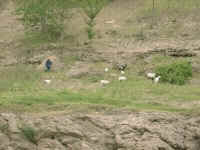|
YANGTZE CRUISE
Friday, 21 April. The Pearl was due to enter the Qutang Gorge at 5:15, so we arose early
and went to the lounge on the fourth deck to watch. As is the rule in this region, there was a
heavy overcast. That plus the early hour gave the gorge an eerie look. The Qutang is the shortest
of the gorges (five miles), but perhaps the most spectacular. There were sheer cliffs very close
on either side. Amazingly, the early Chinese had built a "plank road" above the river. They cut
square holes in the rock every few feet, wedged beams into the holes, then laid planks between
the beams to form a road. Only the holes remain today, though one small section of the road has
been reconstructed.
At 7:00 a.m. we had breakfast and at 9:00 we disembarked at Wushan, where the Danning River joins the Yangtze. A bus took our group a short distance to a pier on the Danning where dozens of motorized sampans were waiting. After boarding, we headed upstream to see the Lesser Three Gorges. This excursion proved to be the most enjoyable part of our Yangtze cruise, and probably of the entire trip. The water level was low, and the river was full of rocks. To keep us off the rocks, there were two polers on the bow. They really had to work hard as we passed through many shallow twists and turns in the river. Besides the tourist sampans, there was a regular "bus" service on the river for local residents. At a couple of points where the water was very shallow, there were landing areas where these "buses" would discharge all their passengers who then had to climb long flights of stone steps and walk a path parallel to the river. Eventually, once they were past the very shallow parts, the "buses" would pick up their passengers again. We were glad we didn't have to go through that.
We passed through Dragon Gate Gorge, Misty Gorge, and Emerald Gorge in succession. In each of these gorges there were steep cliffs, not as high as those in the Yangtze's Three Gorges, but probably more impressive because we were in such a small boat. (The sampan could hold about 30 people, but only our group of 18 was on ours.) In between the gorges, the land flattened out some, and we saw farms, shepherds, and women washing clothes. At one point, first two young boys, then an old man, waded into the water and reached out to our boat with long bamboo poles with a net on the end, begging for contributions. It took us more than three hours to reach the far side of the Lesser Three Gorges. There our sampan tied up, and we ate our box lunches sitting on a large sand bar. We noticed that the boat crew (including the polers) had no lunches. Those in our group had so much more food than we needed that everyone started giving food to the crew. After they had eaten some of it, they would stash the surplus away, either to eat later or take home to their families. For the return trip downstream, a large rudder was attached to the bow of the sampan to guide it through the rocks. It only took one hour to get back to our starting point in Wushan. The shuttle bus got us back to the Victoria Pearl at 2:30, and she left Wushan at 3:45. Soon after, we entered the Wu Gorge (27 miles long) where the Yangtze passes beneath 12 different mountain peaks in the space of just a few miles. This is the only one of the Three Gorges that we entered in full daylight. The weather was so overcast, though, that it didn't make much difference. For the most part, there are no towns or villages along the Yangtze in the gorges themselves because the sides are too steep. Even outside the gorges, the region the upper Yangtze flows through is very mountainous. Nevertheless, the hillsides are farmed and there are many villages and some larger towns overlooking the river. Most of these (a total of 153 towns and 4,500 villages) will be submerged when the new dam is completed and the 370-mile-long lake fills behind it. (The water will rise 440 feet by 2003, and 570 feet by 2009.) In many cases new villages or towns higher up the hillsides have already been built and occupied. The older ones lie abandoned. We were told that, although some older people regret the loss of their ancestral homes, most of the younger ones are delighted to be given modern new homes. On the subject of construction, almost all the buildings we saw in China were masonry of some kind. In the cities, an orangish brick seemed to be the most common. In rural areas, there was some brick, but a gray stone was most prevalent. These stones were cut into rectangular blocks of various sizes by hand! At 6:30 p.m., just as dinner was served, we docked at Zigui at west end of the Xiling Gorge. In addition to our regular lazy-susan fare, the buffet table featured spaghetti and meat balls. Our group (like most of the passengers) ate it ravenously. It would have been considered very poor by Italian standards, but we were desperate for Western food. At 8:00 p.m. we went ashore for a folk performance in a theater on the dock. (They didn't call this one an opera.) We were back on board around 9:00.
Copyright © 2000-2023 DarrellPeck.com All rights
reserved. | ||||


















